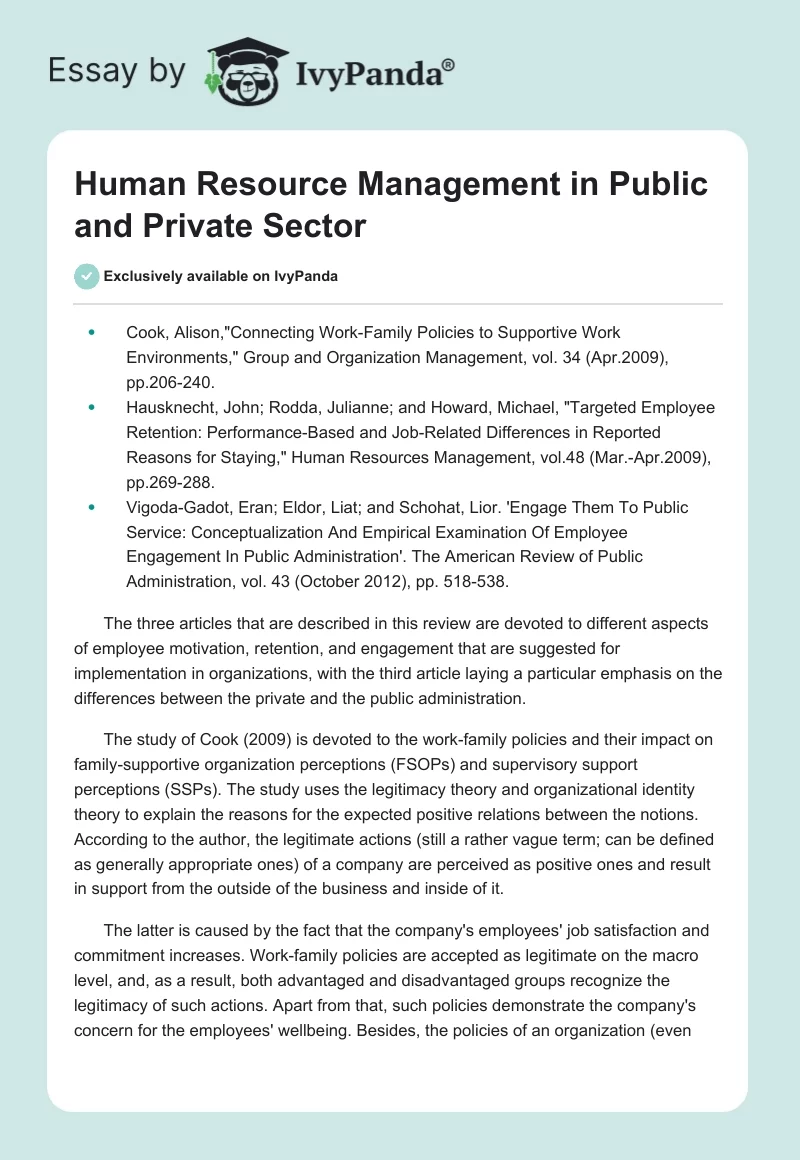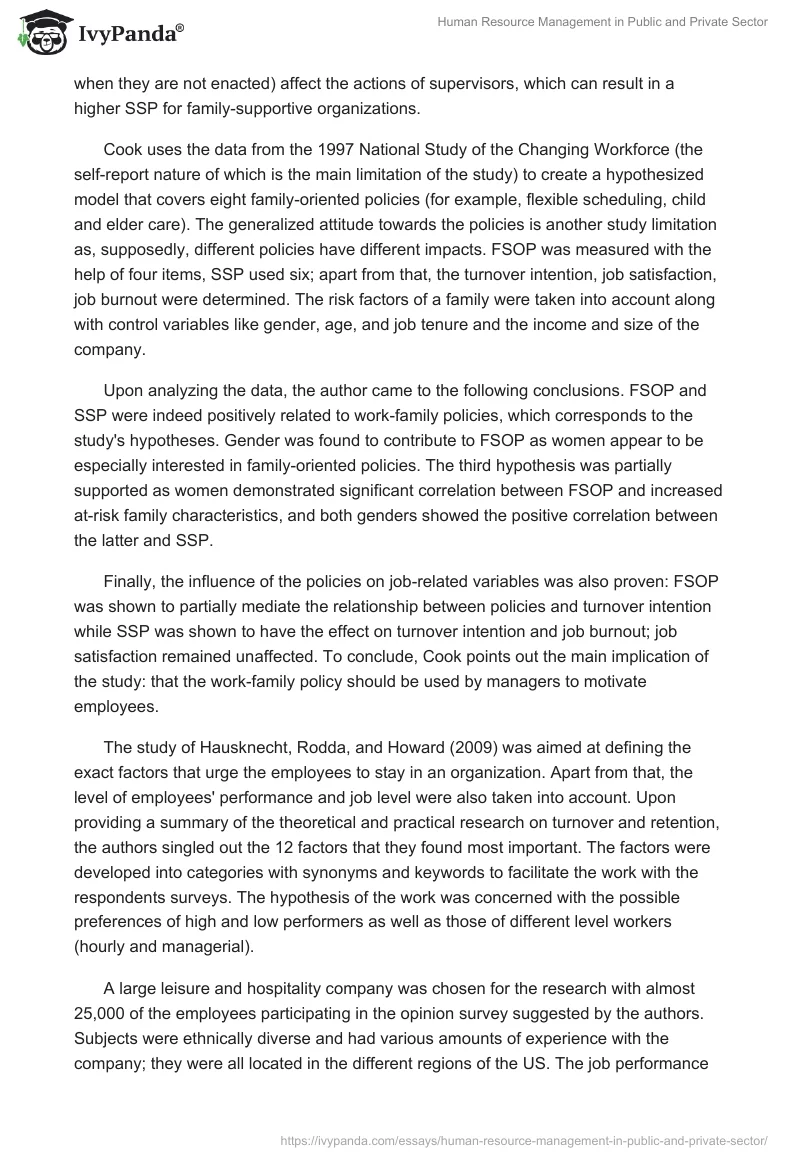- Cook, Alison,”Connecting Work-Family Policies to Supportive Work Environments,” Group and Organization Management, vol. 34 (Apr.2009), pp.206-240.
- Hausknecht, John; Rodda, Julianne; and Howard, Michael, “Targeted Employee Retention: Performance-Based and Job-Related Differences in Reported Reasons for Staying,” Human Resources Management, vol.48 (Mar.-Apr.2009), pp.269-288.
- Vigoda-Gadot, Eran; Eldor, Liat; and Schohat, Lior. ‘Engage Them To Public Service: Conceptualization And Empirical Examination Of Employee Engagement In Public Administration’. The American Review of Public Administration, vol. 43 (October 2012), pp. 518-538.
The three articles that are described in this review are devoted to different aspects of employee motivation, retention, and engagement that are suggested for implementation in organizations, with the third article laying a particular emphasis on the differences between the private and the public administration.
The study of Cook (2009) is devoted to the work-family policies and their impact on family-supportive organization perceptions (FSOPs) and supervisory support perceptions (SSPs). The study uses the legitimacy theory and organizational identity theory to explain the reasons for the expected positive relations between the notions. According to the author, the legitimate actions (still a rather vague term; can be defined as generally appropriate ones) of a company are perceived as positive ones and result in support from the outside of the business and inside of it.
The latter is caused by the fact that the company’s employees’ job satisfaction and commitment increases. Work-family policies are accepted as legitimate on the macro level, and, as a result, both advantaged and disadvantaged groups recognize the legitimacy of such actions. Apart from that, such policies demonstrate the company’s concern for the employees’ wellbeing. Besides, the policies of an organization (even when they are not enacted) affect the actions of supervisors, which can result in a higher SSP for family-supportive organizations.
Cook uses the data from the 1997 National Study of the Changing Workforce (the self-report nature of which is the main limitation of the study) to create a hypothesized model that covers eight family-oriented policies (for example, flexible scheduling, child and elder care). The generalized attitude towards the policies is another study limitation as, supposedly, different policies have different impacts. FSOP was measured with the help of four items, SSP used six; apart from that, the turnover intention, job satisfaction, job burnout were determined. The risk factors of a family were taken into account along with control variables like gender, age, and job tenure and the income and size of the company.
Upon analyzing the data, the author came to the following conclusions. FSOP and SSP were indeed positively related to work-family policies, which corresponds to the study’s hypotheses. Gender was found to contribute to FSOP as women appear to be especially interested in family-oriented policies. The third hypothesis was partially supported as women demonstrated significant correlation between FSOP and increased at-risk family characteristics, and both genders showed the positive correlation between the latter and SSP.
Finally, the influence of the policies on job-related variables was also proven: FSOP was shown to partially mediate the relationship between policies and turnover intention while SSP was shown to have the effect on turnover intention and job burnout; job satisfaction remained unaffected. To conclude, Cook points out the main implication of the study: that the work-family policy should be used by managers to motivate employees.
The study of Hausknecht, Rodda, and Howard (2009) was aimed at defining the exact factors that urge the employees to stay in an organization. Apart from that, the level of employees’ performance and job level were also taken into account. Upon providing a summary of the theoretical and practical research on turnover and retention, the authors singled out the 12 factors that they found most important. The factors were developed into categories with synonyms and keywords to facilitate the work with the respondents surveys. The hypothesis of the work was concerned with the possible preferences of high and low performers as well as those of different level workers (hourly and managerial).
A large leisure and hospitality company was chosen for the research with almost 25,000 of the employees participating in the opinion survey suggested by the authors. Subjects were ethnically diverse and had various amounts of experience with the company; they were all located in the different regions of the US. The job performance was initially self-reported, but with company’s guidance the rates were adjusted. The study helped to single out three key retention factors: job satisfaction (chosen by the half of the respondents), extrinsic rewards (important for 41%), and constituent attachments (chosen by 34%). The hypotheses concerning the retention incentives being influenced by job-level and performance were confirmed, although not every supposition was true.
For example, it was shown that, for high performers, advancement opportunities or job satisfaction were indeed the major reasons to stay, but a similar percentage of both high and low performers appear to have stated the lack of alternatives as am important retention factor. Similarly, transactional retention turned out to be more popular among lower-level employees; managers and professional employees favored extrinsic rewards. Overall, the authors promote the idea of tailored retention strategies, but they also point out that additional research on the topic would be advisable.
The study by Vigoda-Gadot, Eldor, and Schohat (2012) is devoted to employee-organization relationship and employee engagement, particularly in the field of public administration. The study of the topic within this field is underrepresented which has prompted the authors to conduct the research. According to the authors, EE is associated with the multiple-dimensional investment (of physical, affective, cognitive strengths) in work.
The authors also prefer to distinguish EE from affective commitment and job involvement, pointing out that the two latter terms are more specific. According to the authors, EE is connected to the initiative, motivation, and responsibility of the workers. EE is related to the dedication and increasing performance, and, consequently to the service improvement and higher customer satisfaction. The authors expected the public sector employees to have a higher EE and suggested that there would be a correlation between the job level and EE. To test the hypotheses, almost 600 employees from public and private Israel organizations were surveyed; they belonged to different professions and job levels. The EE was measured through three factors: vigor, dedication, and absorption.
The hypotheses were supported by the findings: public sector workers appear to regard the satisfaction of serving society as a motivation of its own. This demonstrates the differences that do exist between public and private sectors, the differences that need to be taken into account by managers working in these sectors. Additional results include the revealed negative relation of EE to job burnout which increases its value to the managers.
Together, the three articles demonstrate the importance of the company’s policies in the fields of family-work relationship, incentives and employee-organization relationship for the employees’ job satisfaction, burnout, and turnover intent. The articles show that these policies can be used as tools for employee retention. Apart from that, the differences between various groups of employees and the sector of the organization (public or private) can also influence the usage of these tools. Tailoring them to serve the needs of a particular organization appears to be a wise course of action. The usage of the mentioned tools in public administration can be facilitated by the fact that the public sector workers tend to have higher commitment, job satisfaction, and engagement levels.


